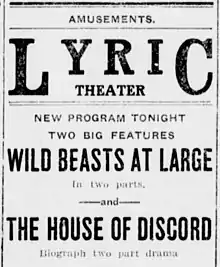The House of Discord
The House of Discord (1913) is a silent American drama film directed by James Kirkwood, Sr., written by F. E. Woods and A. Clayton Harris from a play by William C. deMille. The film stars Lionel Barrymore and marked the theatrical film debut of actor Jack Mulhall.
| The House of Discord | |
|---|---|
 Contemporary advertisement | |
| Directed by | James Kirkwood, Sr. |
| Produced by | Marc Klaw Abraham Erlanger |
| Written by | A. Clayton Harris F. E. Woods William C. deMille (play) |
| Starring | Blanche Sweet Lionel Barrymore Dorothy Gish |
| Cinematography | William T. Crespinel |
| Distributed by | Biograph Company General Film Company |
Release date |
|
Running time | 20 minutes (2 reels) |
| Country | United States |
| Language | Silent film English intertitles |
Synopsis
A mother attempts to save her daughter from making a social mistake after she finds it similar to one she had once faced herself.[1]
Cast
- Marshall Neilan as The Wife
- Blanche Sweet as The Husband
- Jack Mulhall as The Wife's Sweetheart
- Dorothy Gish as The Daughter
- Lionel Barrymore as The Daughter's Sweetheart
- James Kirkwood, Sr. as The Sister-in-Law
- Antonio Moreno as The Sister-in-Law's Sweetheart
Production
The House of Discord was directed by James Kirkwood, Sr. The film stars Lionel Barrymore. In addition to Barrymore, it also stars Blanche Sweet, Dorothy Gish, Marshall Neilan, Antonio Moreno, and Jack Mulhall.[2] This was Mulhall's first theatrical film role; he portrayed a juvenile character which the titular discord centered on.[3][4] The film was produced by Klaw & Erlanger and Biograph Company.[5]
The screenplay was written by F. E. Woods from a play by William C. deMille,[3] and was produced by Marc Klaw and Abraham Erlanger.[6] The film is a silent two-reeler.[3] Cinematographer Tony Gaudio was nearly fired during production after he attempted to reproduce the glow cast from a fireplace, rather than employing the fixed, flat lighting that was accepted practice at the time.[7]
Release
The film was released theatrically on December 13, 1913[8] by the General Film Company.[6] A reviewer for The Moving Picture World wrote that it "will be readily appreciated by women" and that it is a "woman's story" which "reaches its most effective emotional passages in showing the influence of a mother over a daughter who is on the verge of making a serious mistake."[9]
Preservation status
The House of Discord is now in the public domain. A print of the film survives at the Museum of Modern Art in New York City.[6]
References
- Films in Review, Volume 18. National Board of Review of Motion Pictures. 1967. p. 336.
- Photoplay – Volume 17, Issue 1. Macfadden Publications. 1920. p. 64.
- Katchmer, George A. (1991). Eighty Silent Film Stars: Biographies and Filmographies of the Obscure to the Well Known. McFarland & Company. p. 672.
- Wing, Ruth (1923). The Blue book of the screen. p. 176.
- The Barrymores: the royal family in Hollywood. Crown Publishing Group. 1981. p. 339.
- "The House of Discord (1913)". SilentEra.com. Retrieved October 5, 2013.
- Gaudio, G. (1937). "Journal of the Society of Motion Picture Engineers": 160. Cite journal requires
|journal=(help) - Tillmany, Jack (2006). Theatres of Oakland. Arcadia Publishing. p. 106. ISBN 9780738546810.
- The Moving Picture World, Volume 29. World Photographic Publishing Company. 1916. p. 470.